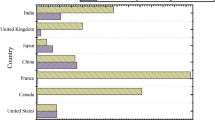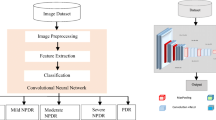Abstract
Fundus disease is the main cause of visual defect in the cases of non-congenital visual disability, where diabetic retinopathy, ischemic optic neuropathy, optic neuritis, and glaucoma are the most common diseases. Early detection and treatment are the key to control fundus lesions. At present, manual diagnosis may lead to the problem of wasting time and misdiagnosis. On this basis, this paper proposes a dual-channel network for multi-disease diagnosis based on retinal varices features and presents a complete fundus retinal image-assisted diagnosis solution. Firstly, on the advice of ophthalmologists, the retinal varices features of various diseases are extracted. Then, combined with the varices attention mechanism, a dual-channel network retinal multi-disease classification model (VAM-DCN) is constructed. Finally, the retinal varices features are put into a dual channel for network learning and training. The proposed method is verified on the clinical data (normal retina, diabetic retinopathy, ischemic optic neuropathy, optic neuritis, and glaucoma) of Dalian NO.3 People's Hospital, and the precision, recall, F1-score, and accuracy can reach 99.44%, 99.39%, 99.41%, and 99.4%, respectively. The proposed method can help ophthalmologist realize the multi-disease classification of fundus retinal images, reduce the possibility of misdiagnosis and missed diagnosis, which has certain clinical medical value.













Similar content being viewed by others
Data availability
The datasets generated during and analysed during the current study are available from the corresponding author on reasonable request.
References
World Health Organization (WHO) (2019) World Report on Vision. Technical Report
Kazuko O et al (2022) Clinical characteristics of glaucoma patients with various risk factors. BMC Ophthalmol 22(1). https://doi.org/10.1186/S12886-022-02587-5
Shaojun Z, Bing L, Chenghu W et al (2022) Screening of common retinal diseases using six-category models based on EfficientNet. Front Med 9. https://doi.org/10.3389/fmed.2022.808402
Grassmann F et al (2018) A Deep learning algorithm for prediction of age-related eye disease study severity scale for age-related macular degeneration from color fundus photography. Ophthalmology 125(9):1410–1420. https://doi.org/10.1016/j.ophtha.2018.02.037
Xianglong Z et al (2019) Automated diabetic retinopathy detection based on binocular siamese-like convolutional neural network. IEEE Access 7:30744–30753
Adem K (2018) Exudate detection for diabetic retinopathy with circular hough transformation and convolutional neural networks. Expert Syst Appl 114:289–295. https://doi.org/10.1016/j.eswa.2018.07.053
Shanthi T, Sabeenian R (2019) Modified Alexnet architecture for classification of diabetic retinopathy images. Comput Electr Eng 76:56–64. https://doi.org/10.1016/j.compeleceng.2019.03.004
Saranya P et al (2021) Blood vessel segmentation in retinal fundus images for proliferative diabetic retinopathy screening using deep learning. Vis Comput 38(3):977–992. https://doi.org/10.1007/S00371-021-02062-0. (prepublish)
Parthiban K, Kamarasan M (2022) Diabetic retinopathy detection and grading of retinal fundus images using coyote optimization algorithm with deep learning. Multimed Tools Appl 82(12):18947–18966. https://doi.org/10.1007/S11042-022-14234-8
Rocha D et al (2022) Diabetic retinopathy classification using VGG16 neural network. Res Biomed Eng 38(2):761–772. https://doi.org/10.1007/S42600-022-00200-8. (prepublish)
Al-Antary MT, Arafa Y (2021) Multi-scale attention network for diabetic retinopathy classification. IEEE Access 9. https://doi.org/10.1109/access.2021.3070685
Clément P et al (2022) Focused attention in transformers for interpretable classification of retinal images. Med Image Anal 82:102608. https://doi.org/10.1016/j.media.2022.102608
Stefano P et al (2023) Characterization of pupillary light response features for the classification of patients with optic neuritis. Appl Sci 13(3):1520. https://doi.org/10.3390/app13031520
Förster A et al (2019) Gadolinium leakage in ocular structures in optic neuritis. J Clin Neurosci 68:268–270. https://doi.org/10.1016/j.jocn.2019.05.050
Lopes Flavio S et al (2019) Structure-function relationships in glaucoma using enhanced depth imaging optical coherence tomography-derived parameters: a cross-sectional observational study. BMC Ophthalmol 19(1). https://doi.org/10.1186/s12886-019-1054-9
Jian G, Xing W, John H (2022) A systematic and sensitive method for critical reagent antibody evaluation with PCA technology. Bioanalysis 14(23):1479–1486. https://doi.org/10.4155/BIO-2022-0195
Naidana K, Barpanda S (2023) A unique discrete wavelet & deterministic walk-based glaucoma classification approach using image-specific enhanced retinal images. Comput Syst Sci Eng 47(1). https://doi.org/10.32604/csse.2023.036744
Jin C et al (2022) Improved weighted non-local mean filtering algorithm for laser image speckle suppression. Micromachines 14(1):98. https://doi.org/10.3390/MI14010098
Anushiadevi R, Amirtharajan R (2023) Separable reversible data hiding in an encrypted image using the adjacency pixel difference histogram. J Inf Secur Appl 72:103407. https://doi.org/10.1016/j.jisa.2022.103407
Reshma S, Gandharba S (2021) Multi-directional pixel difference histogram analysis based on pixel blocks of different sizes. Sens Imaging 22(1). https://doi.org/10.1007/S11220-021-00334-6
Aqsa A et al (2023) Convolutional neural network-based classification of multiple retinal diseases using fundus images. 36(3). https://doi.org/10.32604/iasc.2023.034041
Lingling F, Huan Q (2022) Diabetic retinopathy classification using a novel DAG network based on multi-feature of fundus images. Biomed Signal Process Control 77. https://doi.org/10.1016/j.bspc.2022.103810
Khaled AM, Akhilesh SK, Sachit B (2023) STARC: Deep learning Algorithms’ modelling for STructured analysis of retina classification. Biomed Signal Process Control 80(P2). https://doi.org/10.1016/j.bspc.2022.104357
Edward H et al (2022) Deep ensemble learning for retinal image classification. Transl Vision Sci Technol 11(10). https://doi.org/10.1167/tvst.11.10.39
Jayashree M, Devi UG (2022) A Survey on medical image segmentation based on deep learning techniques. Big Data and Cogn Comput 6(4). https://doi.org/10.3390/BDCC6040117
Jun C (2022) Classification and model method of convolutional features in sketch images based on deep learning. Int J Patt Recogn Artif Intell 36(12). https://doi.org/10.1142/S0218001422520206
Hongxia Y (2022) Modeling and analysis of multifocus picture division algorithm based on deep learning. J Funct Spaces 2022. https://doi.org/10.1155/2022/8326626
Xuxin C et al (2022) Recent advances and clinical applications of deep learning in medical image analysis. Med Image Anal 79. https://doi.org/10.1016/j.media.2022.102444
Xuehua H (2022) Improved model based on GoogLeNet and residual neural network ResNet. Int J Cogn Inform Nat Intell (IJCINI) 16(1). https://doi.org/10.4018/ijcini.313442
Acknowledgements
This work was supported by Natural Science Foundation of Liaoning Province under Grant 2021-MS-272, and Educational Committee project of Liaoning Province under Grant LJKQZ2021088. Thanks to Siyu Sun, ophthalmologist of Dalian NO.3 People's Hospital, for providing clinical data for this paper.
Author information
Authors and Affiliations
Corresponding author
Ethics declarations
Conflict of interest
The authors declare that they have no conflict of interest.
Additional information
Publisher's Note
Springer Nature remains neutral with regard to jurisdictional claims in published maps and institutional affiliations.
Rights and permissions
Springer Nature or its licensor (e.g. a society or other partner) holds exclusive rights to this article under a publishing agreement with the author(s) or other rightsholder(s); author self-archiving of the accepted manuscript version of this article is solely governed by the terms of such publishing agreement and applicable law.
About this article
Cite this article
Fang, L., Qiao, H. Retinal multi-disease classification using the varices feature-based dual-channel network. Multimed Tools Appl 83, 42629–42644 (2024). https://doi.org/10.1007/s11042-023-17127-6
Received:
Revised:
Accepted:
Published:
Issue Date:
DOI: https://doi.org/10.1007/s11042-023-17127-6




